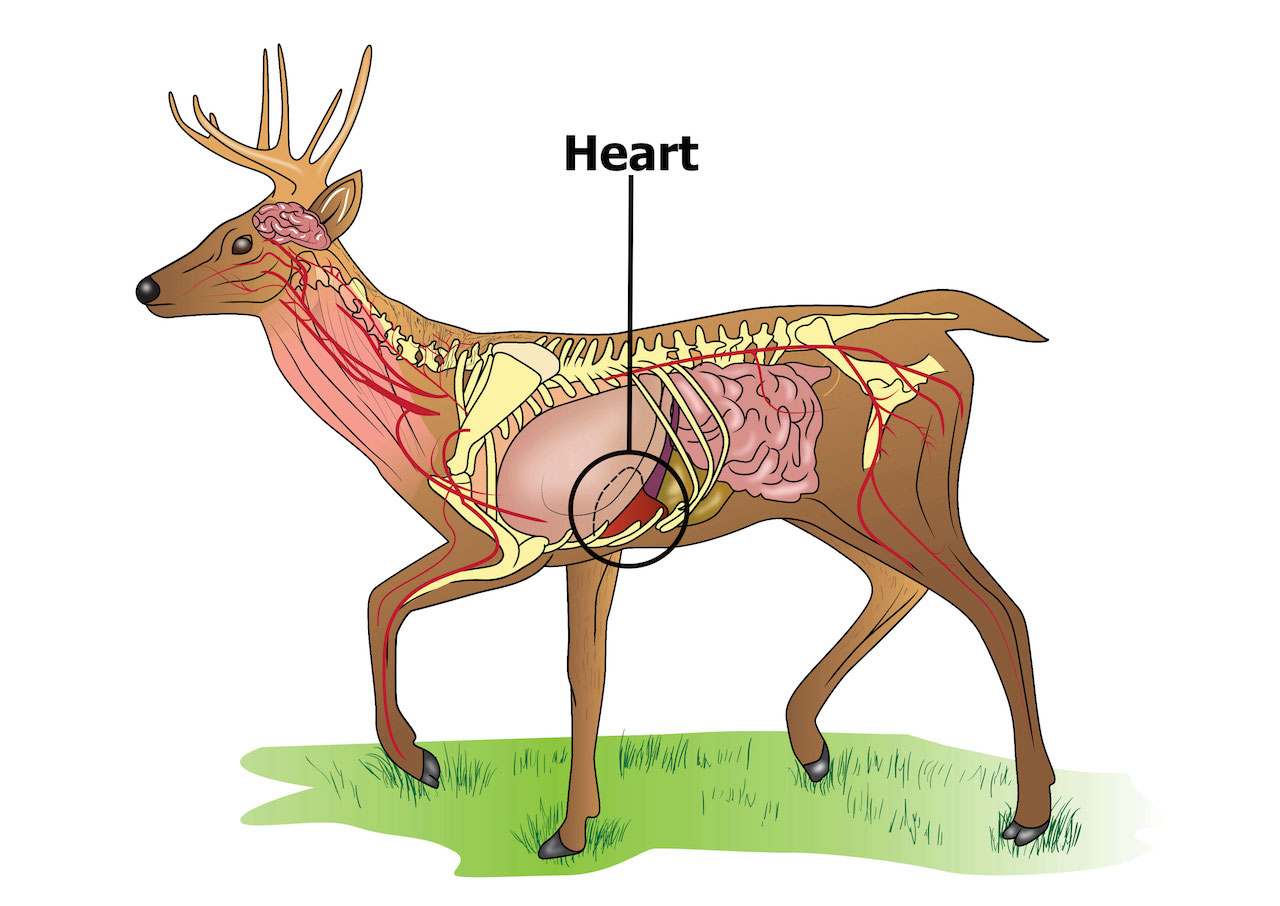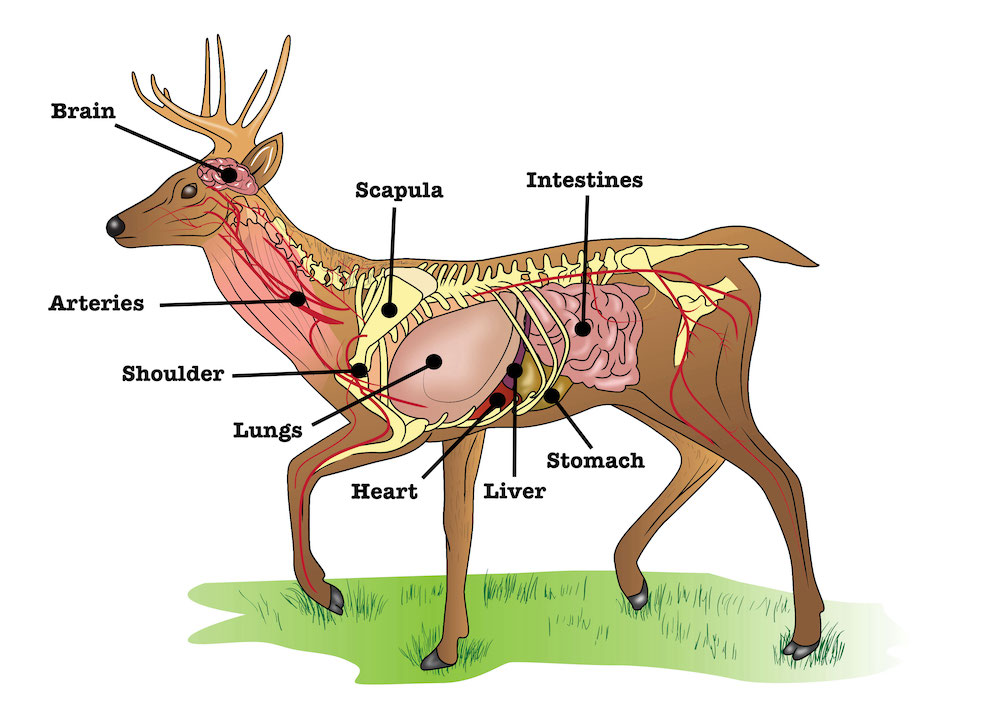Last Updated on March 19, 2024 by Jason Tome
Understanding deer anatomy is crucial both before and after taking a shot. It provides essential guidance on precise shot placement and the right approach to blood trailing a deer for both good and sub-par shots. This knowledge is fundamental for ethical hunting, ensuring a humane and swift kill, and making well-informed decisions when pursuing a deer after a shot, whether it was a good or bad shot.
You may have come across this article seeking answers after successfully hitting a deer, eager to determine the effectiveness of your shot. You’ll find the answers you’re looking for in this article.
Additionally, for a more detailed exploration of deer shot placement, you may find the resource “Where To Shoot A Deer | Best Deer Shot Placement (With Pictures)” beneficial.
Table of Contents
Deer Anatomy Diagram
Deer Vitals |Learn Where To Shoot A Deer Using Deer Anatomy
Heart
The heart is a fairly small organ and is one of the best places to shoot a deer for a few reasons:
- The heart is slightly encompassed by the lungs.
- The majority of the lungs are found directly above the heart.
- Compensates for string jumping deer.
- Deer will expire quickly.

Distance plays a role in where you should shoot a deer with a bow. At further distances, the deer can react to the sound of your bowstring when it’s shot. They instinctually load their legs to run, which makes it look like they are ducking the arrow.
Since the heart is the lowest vital organ in a deer, if you aim for the heart and the deer tries to duck your arrow, you’ll still often hit the lungs which is also a great place to shoot a deer.
If the deer doesn’t duck the arrow then you’ll hit the heart. Deer that are shot in the heart will generally fall within 100 yards. A good rule of thumb is waiting 1 hour after a heart shot with a bow before taking up the blood trail.
Lungs
The lungs are one of the quickest and most ethical places to shoot a deer for a few reasons:
- They have a lot of capillaries and blood vessels.
- Deer won’t be able to breathe after they’ve been shot.
- Good blood trails.
- The lungs are a large target.
As mentioned above, the lungs are another good spot to shoot a deer. Lungs have a lot of blood vessels and capillaries, the lungs need to have a lot of these because it helps animals assimilate oxygen. For this reason, a lot of bleeding will occur when the lungs are shot. Additionally, without the use of lungs, a deer cannot breathe for very long.
This combination leads deer to expire quickly and ethically. Deer usually don’t go more than 100 yards after a double-lung shot. A single lung shot is not as effective and the deer may run for a really long distance, and you may never find it.
When you’re aiming for the lungs always try to get both lungs. If you can only get a single lung because of the deer’s orientation, try to hit another vital organ in combination; such as the heart or liver.
A good rule of thumb is waiting for 1-hour after a double-lung shot with a bow before taking up the blood trail.
Liver
The liver is a decent place to shoot a deer with a bow, but it is never my goal to try to shoot the liver. I am always aiming for the heart and lungs. If the liver gets in the way then I consider that a bonus.
The liver is located behind the lungs and is sometimes hit by accident when aiming for the lungs. This can be a blessing when you think you’ve made a bad shot too far back toward the stomach.
Although it takes more time for the deer to expire than a heart or lung shot, it is still one of the quickest and most ethical places to shoot a deer.
When recovering a deer that has been shot in the liver a good rule of thumb is to wait 2-3 hours before taking up the blood trail.
Brain
The brain is another organ that when shot will drop a deer dead in its tracks. However, the brain is a very small target and if you end up missing the brain and wounding the deer in the head area it will likely be a slow and painful death for the deer.
For this reason, it is advised not to aim for the brain if there is potential for a better shot. Usually, there is if you wait for the deer to move to a better position.
If you’re very confident in your setup and have a very easy shot, the brain is one of the quickest and most ethical places to shoot a deer.
Spine
The spine is another organ that when hit will immediately drop a deer in its tracks. However, the spine is also a tough target to hit. If you end up missing the spine low you’ll often hit what is referred to as ‘no-mans land’ which is a spot between the spine and lungs that is just meat.
This will end up wounding the deer and most of the time these deer are not recoverable. For this reason, it is advised not to aim for the spine if there is potential for a better shot.
Almost always there is a better shot if you wait for the deer to move to a better position. If you’re very confident in your setup and have a good shot, the spine is one of the quickest and most ethical places to shoot a deer.
I would personally rather wait for a better shot at the lungs, heart, or liver.
High-Shoulder Scapula Shot
The high-shoulder or scapula shot is becoming a more popular place to shoot a deer because it will drop a deer dead in its tracks. This shot works well because the scapula bone is less thick than the shoulder joint.
This allows a bullet to break both shoulders easily. With both shoulders broken the deer is not able to run because it has lost the use of both of its front legs.
In addition, this shot is close to the lungs and the spine so if you don’t hit exactly where you want you’ll more than likely hit something else that is vital. The high shoulder scapula shot is a great place to shoot a deer for quick ethical kills.
Deer Anatomy| Where Not To Shoot A Deer
Shoulder Joint
A direct shot to the shoulder joint is not a good place to shoot a deer. The shoulder is a thick bone and bullets don’t always make it through the bone. This can wound a deer by breaking one leg and not hitting anything lethal or possibly puncturing only a single lung.
To get maximum penetration in order to hit the vitals, it is not recommended to shoot through the large bone of the shoulder joint.
Stomach & Intestines
Shooting a deer in the stomach and intestines should be avoided at all costs. A deer shot here will die but it will usually take 12 hours or so for the deer to expire. This a long and painful way to die for a deer, shooting a deer in the stomach is not an ethical shot. Sometimes accidents happen though and they can’t be avoided.
If you end up shooting a deer in the stomach the best thing you can do is to wait 12 hours and then pick up the track. It is almost guaranteed that the deer will lie down after getting shot in the stomach and will expire in its first bed if not disturbed.
If you start blood trailing too soon, the deer will run away from its bed and it will become exponentially harder to recover the deer. Normally, there will be no blood trail to follow when the deer is hit in the stomach.
Arteries & Veins
Just like all animals, deer have arteries and veins. And although it is deadly if you hit a deer in the main arteries or veins like the carotid or jugular, they are not very ethical shots to take because they are not easily visualized with the naked eye.
This makes them very hard to hit consistently. It is recommended to wait for a better shot. Consider it a bonus when arteries and veins are hit in addition to good shot placement.
More Deer Anatomy Resources
Where To Shoot A Deer | Best Deer Shot Placement (With Pictures)
Questions & Community
Understanding deer anatomy is crucial for making proper shot placement and recovering deer effectively. If you have questions you can find links to where I can be reached below:

